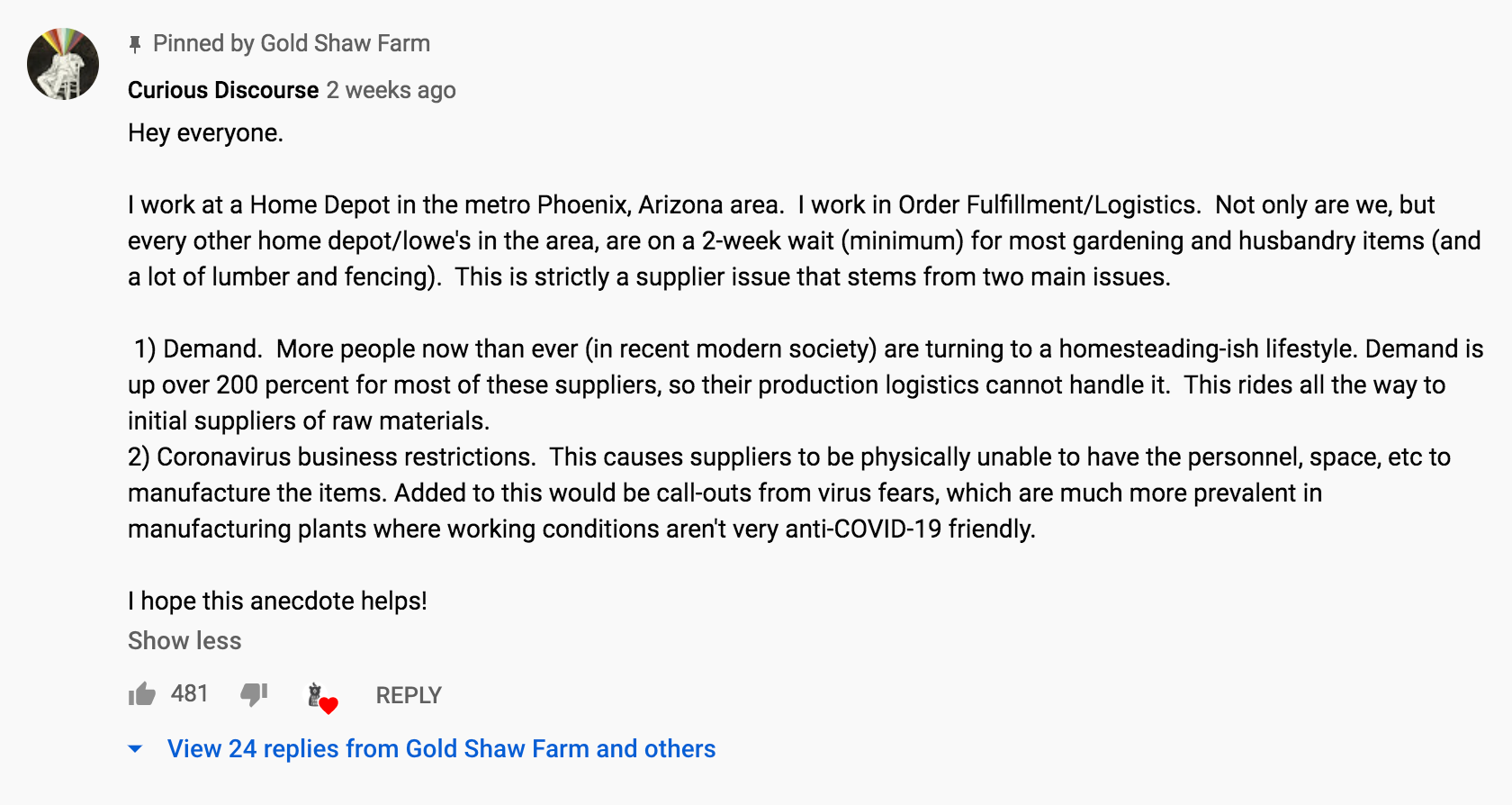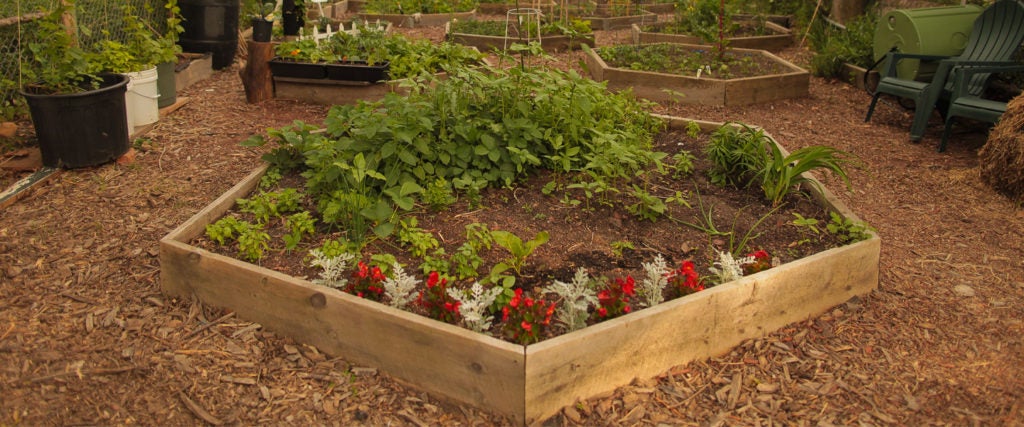Like many small farmers, Morgan Gold of Gold Shaw Farm in Peacham, Vermont relies on stores like Lowe’s, Home Depot and Tractor Supply Company, so when he recently found himself needing more hardware cloth to finish building a chicken tractor, he hopped into his truck and went shopping.
He stopped at Lowe’s: There was no hardware cloth. He stopped at Home Depot: The shelves had been ransacked. He stopped at Tractor Supply Company: Nothing. He even desperately stopped at Walmart.
The hardware cloth that he needed was nowhere to be found.
Since the public was first informed about the coronavirus, Gold has been struggling to get his hands on the basic supplies and services he needs to keep his farm up and running, from duck feed to hardware cloth to reservations at the slaughterhouse, and he suspects that a sudden boom in quarantine farming could be partly to blame. “There has been a massive spike in demand between 2019 and 2020,” he says. “That has definitely made it harder to get certain things done this year.”
No doubt, hobby farming has seen a spike in popularity as people spend more time at home, many still disturbed by reports of meat shortages and empty supermarket shelves from when the coronavirus first struck. “We were all sort of under lockdown,” says David Ortega, associate professor at the Michigan State University department of agricultural, food and resource economics. “That’s when we saw a big increase in interest from average consumers — everyday people, non-farmers — wanting to get into gardening. There were fears of the meat shortages that were on the news in April and May, so people felt like, ‘Okay, we need to stock up on food, but maybe we can start that garden and get some leafy greens going to help supplement.’”
This quarantine is going to make some very nice gardens happen. Like this one. Work in progress. Top photo is Google Streetview from before we moved in.
Previous owner had a thing for gravel. Did not like trees. They also thought low maintenance meant no maintenance…. pic.twitter.com/kue00GsZfe
— Christopher Dowson is socially distant (@myfirstraygun) March 25, 2020
Those with the backyard space also started buying up livestock. “There was a huge rush on backyard chickens,” Ortega says. “Tractor Supply Company — all of those businesses — they were running out of little chicks. There was also a run on garden seeds, and with that came the purchasing of gardening equipment.” And when hordes of farming newcomers flocked to farming supply stores to shop for their hobby gardens, they left nothing for small but professional farmers like Gold.
Jackson is one such farming newcomer. He has a plot of land in rural Washington, where he hosts five chickens, two goats, a garden of leafy greens, several young fruit trees and a rainwater collection system, much of which he ramped up when quarantine started. “There may come a time when the people who have land need to produce to hold the rest of society up,” he tells me. “We saw the grocery store collapse for a few weeks. That scared the shit out of me.”
Jackson does, however, sympathize with the plight of small farmers who are suddenly having to compete with newbies like himself — he watched his neighbor, a small chicken farmer, face challenges related to the coronavirus — and he even admits to having trouble getting his own newly green thumbs on seeds and the like. But he also argues that while hobby farmers have contributed to the problems that professional farmers are currently facing, those challenges are more a result of issues within our supply chains.
Indeed, an increase in hobby farming is only the tip of the iceberg when it comes to additional pressure on small farmers like Gold. “I wouldn’t blame it all necessarily on the hobby farmers,” Ortega says. “You have to keep in mind that a lot of these small farmers — the small producers — and even the large producers are facing other hardships. The food service industry shut down in mid-March, and that wiped out a huge market for them. We’ve seen farmers having to bury their potatoes, or when we get to livestock farmers, a few of them have had to euthanize or depopulate their herds.”
Likewise, the coronavirus had huge, unforeseen impacts on many supply chains, and for seasonal businesses like agriculture, even one hurdle can result in a major disaster. “We have to keep in mind that the pandemic wasn’t seen for months ahead of time in terms of the type of impact it would have on the economy,” Ortega explains. “It takes time to produce seeds, and there weren’t forecasts that saw a huge rush on garden seeds or even supplies. So it takes time to ramp up that production. Agriculture is very seasonal.”
Under a YouTube video that Gold published about farming supply shortages, a Home Depot fulfillment employee explains how coronavirus-inspired business restrictions have made it near impossible for suppliers to keep up with the increase in demand:

In addition to supply shortages, Cole Sonne of Sonne Farms in South Dakota explains that labor shortages are another massive problem impacting farmers, because slaughterhouses and the like can no longer be stuffed to the brim with staffers under new, coronavirus-inspired precautionary measures. “It seems the biggest issue is that the protein producers [pork and beef] are having a tough time getting our products into the processing plants,” he says. “Since the workers at those places often work in close conditions, the virus can be transmitted easily. This results in the closure of these plants, so even though beef and pork are in high demand, all of the animals that are ready to go in can’t, because the plants can’t handle them.” Transportation, of course, has been similarly affected.
In turn, Gold explains that larger farms not being able to rely on their usual processors has resulted in them creeping into processors that small farmers would normally use. “As the large-scale factory farms struggle to find processing, they’re often moving into the space that a lot of mid-scale farms would be using,” he explains. “Then those mid-sized farmers are eating into the processing capacity that a lot of small-scale farmers are using.”
The end result is that small farmers again get the short end of the stick. “I’ve given up on the idea of taking my birds to a processor this year,” Gold says. “I’m just making plans later this fall to butcher all the birds here on the farm.”
But despite these challenges, Gold is confident that he can make do. “Forcing me to be more self-reliant and creative is definitely what it’s done,” he says. “Necessity is the mother of invention. Well, some of the necessities here are forcing us to be inventive.”
In fact, Gold recognizes that, while momentarily frustrating, more hobby farmers may have long-term benefits on his industry and the world as a whole. “More small-scale producers is a good thing,” he says. “If anything, the last couple of months have taught us that having a more local supply chain for your food and having more options at a smaller scale has the benefit of making you a much more resilient community. This is a good thing, and it’s a good broader trend that we’re seeing within American society. It’s just, there are some growing pains.”
Sonne agrees. “We’re all trying to stay ‘alive’ as farmers and keep going,” he says. “When people at home have a hard time getting their normal produce and food items, and they try to grow for themselves, we hope they learn an appreciation for the farmers and realize the difficulty involved when trying to feed the world.”
Gold adds, “Anybody who raises their own batch of meat birds, for example, and then processes them themselves — they’ll walk away from that experience never again feeling good about eating cheap, factory-produced chicken, because they know how much work and effort goes into raising a good, healthy bird.”
Likewise, Ortega notes that, while scary, watching our supply chains buckle, then rebound under the stress of this pandemic was an important lesson for Americans. “One thing that this pandemic has done is make people think about where their food really comes from,” he says. “This is probably the largest stop that any of us in our lifetimes have experienced to the economy, and the food system in particular. And these stock-outs were temporary. If you go to the grocery store, the product is flowing again.”
So while the farming industry as a whole — and especially small farmers like Gold — have a long road ahead of them, we can only hope that these struggles serve as lessons to improve the general understanding and effectiveness of our food systems. And, of course, we can only hope that our quarantine gardens prosper, so we can be prepared if, God forbid, grocery stores go to shit again.

